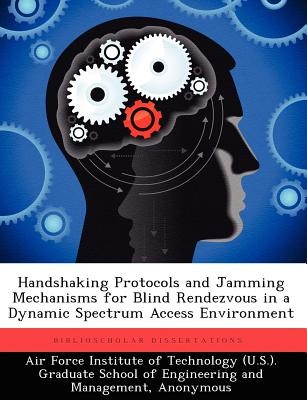
- We will send in 10–14 business days.
- Author: Aaron A Gross
- Publisher: BiblioScholar
- ISBN-10: 1249358833
- ISBN-13: 9781249358831
- Format: 18.9 x 24.6 x 0.6 cm, softcover
- Language: English
- SAVE -10% with code: EXTRA
Handshaking Protocols and Jamming Mechanisms for Blind Rendezvous in a Dynamic Spectrum Access Environment (e-book) (used book) | bookbook.eu
Reviews
Description
Blind frequency rendezvous is an important process for bootstrapping communications between radios without the use of pre-existing infrastructure or common control channel in a Dynamic Spectrum Access (DSA) environment. In this process, radios attempt to arrive in the same frequency channel and recognize each other's presence in changing, under-utilized spectrum. This paper refines existing blind rendezvous techniques by introducing a handshaking algorithm for setting up communications once two radios have arrived in the same frequency channel. It then investigates the effect of different jamming techniques on blind rendezvous algorithms that utilize this handshake. The handshake performance is measured by determining the probability of a handshake, the time to handshake, and the increase in time to rendezvous (TTR) with a handshake compared to that without. The handshake caused varying increases in TTR depending on the time spent in each channel. Four different jamming techniques are applied to the blind rendezvous process: noise, deceptive, sense, and Primary User Emulation (PUE). Each jammer type is analyzed to determine how they increase the TTR, how often they successfully jam over a period of time, and how long it takes to jam. The sense jammer was most effective, followed by PUE, deceptive, and noise, respectively.
EXTRA 10 % discount with code: EXTRA
The promotion ends in 17d.09:46:27
The discount code is valid when purchasing from 10 €. Discounts do not stack.
- Author: Aaron A Gross
- Publisher: BiblioScholar
- ISBN-10: 1249358833
- ISBN-13: 9781249358831
- Format: 18.9 x 24.6 x 0.6 cm, softcover
- Language: English English
Blind frequency rendezvous is an important process for bootstrapping communications between radios without the use of pre-existing infrastructure or common control channel in a Dynamic Spectrum Access (DSA) environment. In this process, radios attempt to arrive in the same frequency channel and recognize each other's presence in changing, under-utilized spectrum. This paper refines existing blind rendezvous techniques by introducing a handshaking algorithm for setting up communications once two radios have arrived in the same frequency channel. It then investigates the effect of different jamming techniques on blind rendezvous algorithms that utilize this handshake. The handshake performance is measured by determining the probability of a handshake, the time to handshake, and the increase in time to rendezvous (TTR) with a handshake compared to that without. The handshake caused varying increases in TTR depending on the time spent in each channel. Four different jamming techniques are applied to the blind rendezvous process: noise, deceptive, sense, and Primary User Emulation (PUE). Each jammer type is analyzed to determine how they increase the TTR, how often they successfully jam over a period of time, and how long it takes to jam. The sense jammer was most effective, followed by PUE, deceptive, and noise, respectively.


Reviews